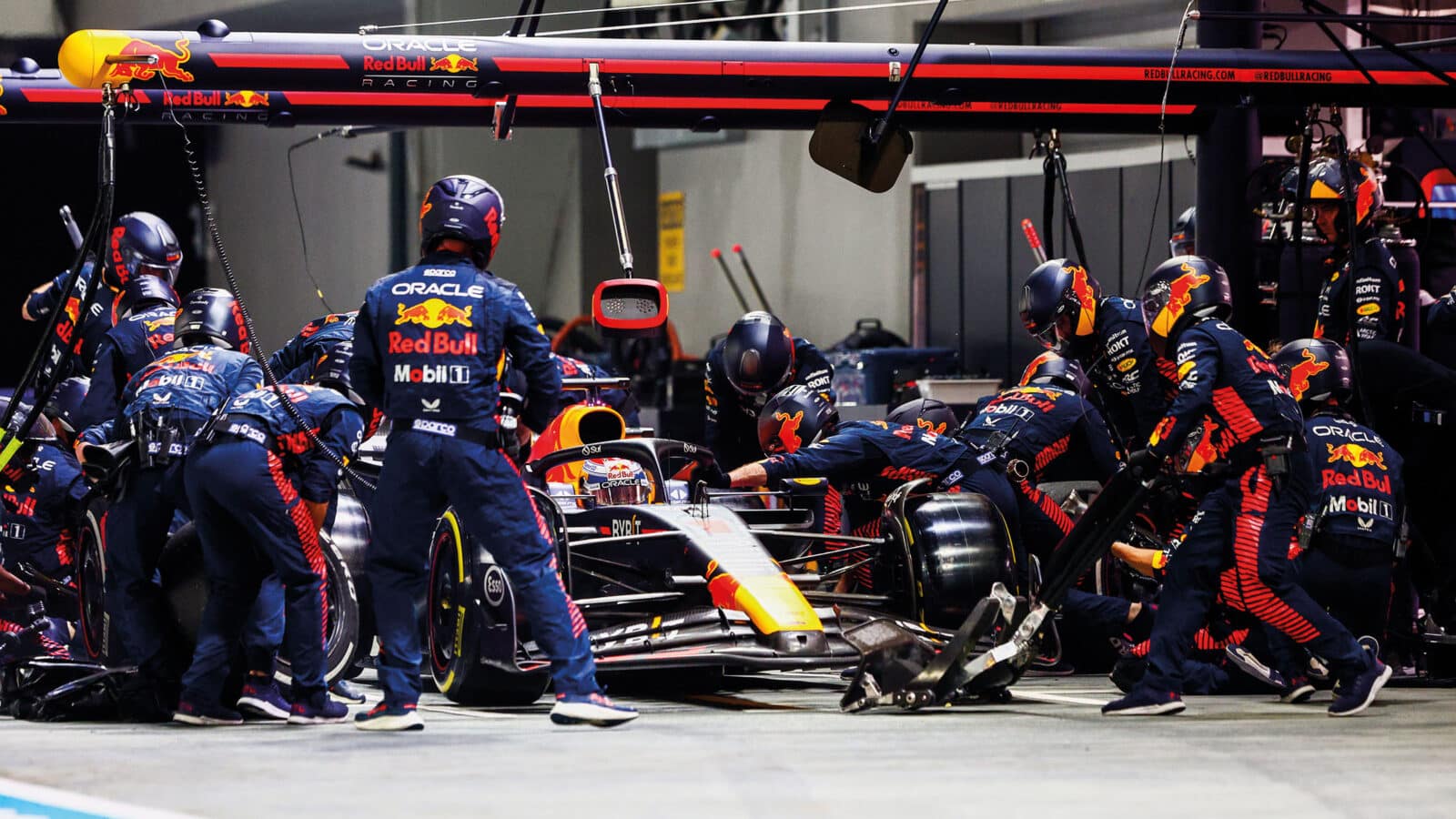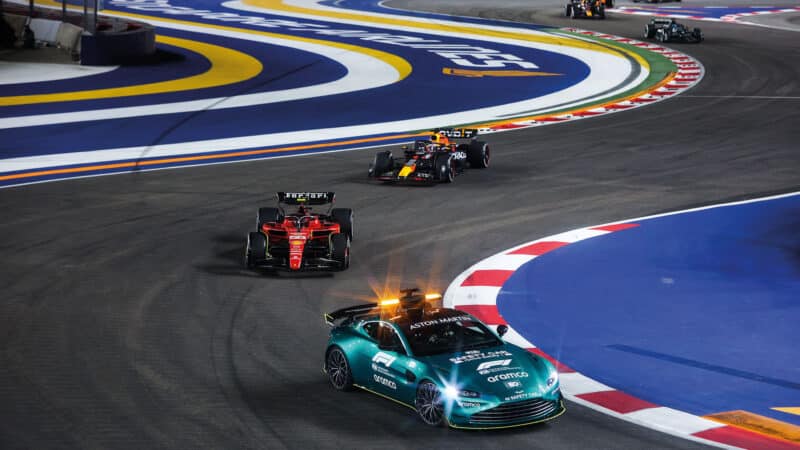The crash that cost red Bull in Singapore GP
Marina Bay gave us an unusual spectacle – a race without a Max Verstappen victory. Mark Hughes explains how an early Williams mistake took the fizz from the Red Bull Singapore GP strategy

Singapore’s slow pitlane combined with an untimely safety car punctured Red Bull’s only hopes
Having qualified a shock 11th and 13th fastest in Singapore, Red Bull was looking for a strategic route to rescue its weekend come the race. The reduction of the speed limit in what was already a time-costly pitlane moved the race even more towards a one-stop than previously and the favoured strategy for almost every car ahead of them was to run a medium-hard combination. Given that a two-stop would be too slow and the soft tyre didn’t have the range required to do a one-stop, the only tyre offset available to Red Bull was to start on the hards, run long and be on much faster fresh mediums when everyone else was on old hards in the race’s late stages.
The potential hazard of the plan was a safety car coming early enough for the medium starters to pit but too early for the Red Bulls. Given that the mediums to which Red Bull would be switching had a range of only around 30 laps and it was a 62-lap race, any safety car earlier than lap 32 would be disadvantageous. It was lap 20 when Logan Sargeant put his Williams nose-first into the barriers. He reversed it out and got going again but the debris trail he left as he drove to the pits with part of his front wing trapped beneath the car brought out the safety car. It was almost perfect timing for the medium runners and disastrous timing for Red Bull, with both cars obliged to stay out and unable to take advantage of the 15sec saving over the field a safety car stop offers.
Two things could have rescued their race from there: 1) another safety car late enough for Red Bull to get onto the mediums, thereby cancelling out the advantage the others had taken from the first one. Or 2) if Verstappen – who was second in the safety car queue behind race leader Sainz – could get in front of Sainz on the restart, thereby delaying everyone else. In reality that was a near-impossibility given how much slower his cold hard tyres were than the new mediums of Sainz and almost everyone else.
“In fact Verstappen and Pérez sank like stones on cold tyres”
In fact, Verstappen and Pérez sank like stones from their artificially boosted positions. It’s very difficult to get cold hard tyres with 20 racing laps on them already to ‘wake up’. Within a few laps of the restart Verstappen had sunk from second to sixth. Verstappen and Pérez stayed out there for as long as possible in the hope of a second safety car, but it was in vain. Pérez finally came in on lap 39, Verstappen on lap 40, with their rear tyres absolutely finished. The pitstop loss to the field at full racing speed was 29sec. Verstappen rejoined near the back, 43sec off the lead (with Pérez a further 9sec back). Now on medium tyres that were 20 laps newer than the hards of almost everyone else, Verstappen was able to quickly pick off the midfield runners. With two laps to go he was 7sec behind Charles Leclerc’s Ferrari but catching fast. He was just 0.2sec behind as they took the chequered flag.
Without the 15sec extra pitstop time loss compared to those who stopped in the safety car period, Verstappen on his fresh medium tyres would have been upon Leclerc (who was struggling with an overheating PU) many laps earlier and lapping much faster than the old-tyred Sainz and Norris at the front. As the two Mercedes were then restricted to the Sainz-imposed pace, so Verstappen would have been on Hamilton’s tail several laps before the end and with that dynamic, a quite different race might have played out.

An early safety car was just what Verstappen did not need – but it happened, thanks to Sargeant
 Marina Bay – Circuit
Marina Bay – Circuit
Select a year
Type
Temporary street circuit
Length
3.07 (Miles)
Change
Turns 16-19 bypassed
Fastest Race Lap
Lewis Hamilton (Mercedes-Benz F1 W14 E Performance), 1m35.867, 115.285 mph, F1, 2023
Fastest Qualifying Lap
Carlos Sainz (Ferrari SF-23), 1m30.984, 121.472 mph, F1, 2023
Type
Temporary street circuit
Length
3.146 (Miles)
Change
Turns 16 and 17 modified
Fastest Race Lap
Kevin Magnussen (Haas VF-18-Ferrari), 1m41.905, 111.139 mph, F1, 2018
Fastest Qualifying Lap
Lewis Hamilton (Mercedes-Benz F1 W09 EQ Power+), 1m36.015, 117.957 mph, F1, 2018
Type
Temporary street circuit
Length
3.147 (Miles)
Change
Turns 11-13 modified
Fastest Race Lap
Lewis Hamilton (Mercedes-Benz W08), 1m45.008, 107.889 mph, F1, 2017
Fastest Qualifying Lap
Sebastian Vettel (Ferrari SF70H), 1m39.491, 113.872 mph, F1, 2017
Type
Temporary street circuit
Length
3.147 (Miles)
Change
Turn 10 chicane bypassed
Fastest Race Lap
Sebastian Vettel (Red Bull RB9-Renault), 1m48.574, 104.346 mph, F1, 2013
Fastest Qualifying Lap
Sebastian Vettel (Red Bull RB9-Renault), 1m42.841, 110.162 mph, F1, 2013
Type
Temporary street circuit
Length
3.152 (Miles)
Change
Turn 10 chicane modified, Turns 13 and 14 reprofiled
Fastest Race Lap
Fernando Alonso (Ferrari F10), 1m47.976, 105.090 mph, F1, 2010
Fastest Qualifying Lap
Sebastian Vettel (Red Bull RB7-Renault), 1m44.381, 108.710 mph, F1, 2011
Type
Temporary street circuit
Length
3.148 (Miles)
Change
Original circuit
Fastest Race Lap
Kimi Raikkonen (Ferrari F2008), 1m45.599, 107.319 mph, F1, 2008
Fastest Qualifying Lap
Felipe Massa (Ferrari F2008), 1m44.014, 108.955 mph, F1, 2008
